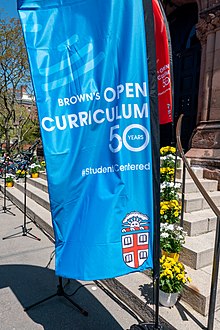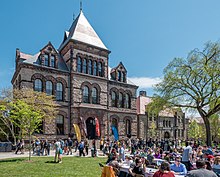Open Curriculum (Brown University)

Brown University is well known for its undergraduate Open Curriculum, which allows students to study without any course requirements outside of their chosen concentration (major).[1][2][3] To graduate from Brown's College, students need only have taken 30 courses, completed a concentration, and demonstrated fluency in the writing of English. Adopted in 1969 after the circulation of a report by Brown undergraduate students Ira C. Magaziner and Elliott E. Maxwell.[4][5][6][7] The open curriculum distinguishes Brown from peer schools—particularly those with core curricula, like Columbia University and the University of Chicago—and has become one of the university's best-known attributes.[8]
History
From its founding in 1764 as one of America's nine Colonial colleges, Brown (originally called Rhode Island College) was characterized by a spirit of openness: it became the first college in the United States to accept students regardless of their religious background, a practice dating from its founding charter.[9][10][11]
While in early years Brown's curriculum was similar to that of Princeton (where Brown's first president, James Manning, had studied), with its emphasis on the Classics, President Francis Wayland instituted a series of curricular reforms in the 1850s, aimed at modernizing and diversifying Brown's offerings.[12] With Wayland's reforms, students could now study modern languages, and applied sciences.[13] Another important influence on the development of the Open Curriculum was the institution of "University Courses" in 1958: these were intimate discussion-style classes that were interdisciplinary in their nature, and therefore affiliated with no single department.
In 1966, seventy Brown undergraduates formed a Group Independent Study Program to scrutinize Brown's curriculum, and propose reforms. By 1968, the group comprised twenty-five students, two of whom, Ira Magaziner and Elliott Maxwell, wrote a substantive 400-page report, "Draft of a Working Paper for Education at Brown."[14][5][15] The report called for the institution of several reforms, including:
- The elimination of all distribution requirements in favor of an "Open Curriculum"
- The elimination of pluses and minuses when grading
- The option to take courses on a Satisfactory/No Credit basis rather than receiving traditional grades
- The introduction of "Modes of Thought" courses for freshmen
Though Brown's administration was at first reluctant to entertain the report, eventually a faculty meeting was called after Maxwell and Magaziner personally visited every Brown professor. After a two-day faculty meeting, Brown's faculty agreed to implement the New Curriculum.[16]
50th anniversary

In May 2019, Brown began a 12-month commemoration and celebration of the 50th anniversary of the Open Curriculum.[17] A steering committee was established to guide the "community exploration," which included a picnic, readings, speaking programs, and other events.[17]
External links
- The Magaziner-Maxwell Report is available here.
References
- ISSN 0362-4331. Retrieved 2019-02-16.
- ISBN 9781476702728.
- ^ "Brown University and others consider lessons of its open curriculum, now 50 years old". www.insidehighered.com. Retrieved 2019-05-06.
- ISSN 0362-4331. Retrieved 2019-02-16.
- ^ ISBN 978-0-500-25216-1.
- ISBN 9781136279102.
- ISBN 9780203111628, retrieved 2022-09-05
- ^ Geismer, Lily (2022-09-02). "How the "Chill Ivy" Decided to Give Its Students Absolute Freedom". Slate Magazine. Retrieved 2022-09-05.
- ISBN 9780742548398.
- ISBN 9781412815383.
- ISBN 9780801878558.
colonial college college of rhode island.
- ^ "Encyclopedia Brunoniana | Curriculum". www.brown.edu. Retrieved 2019-02-17.
- ISBN 9781351480307.
- ^ Guterl, Matthew Pratt (2014-07-21). "Why We Need an Open Curriculum". The Chronicle of Higher Education Blogs: The Conversation. Archived from the original on 2019-02-17. Retrieved 2019-02-17.
- ISSN 0362-4331. Retrieved 2019-02-17.
- ^ "The Art of the Possible: Ira Magaziner '69". Brown Political Review. 2014-05-20. Retrieved 2019-02-17.
- ^ a b Hyde-Keller, Orya (15 April 2019). "Brown to launch yearlong celebration, exploration of Open Curriculum at 50 years". Brown University.
